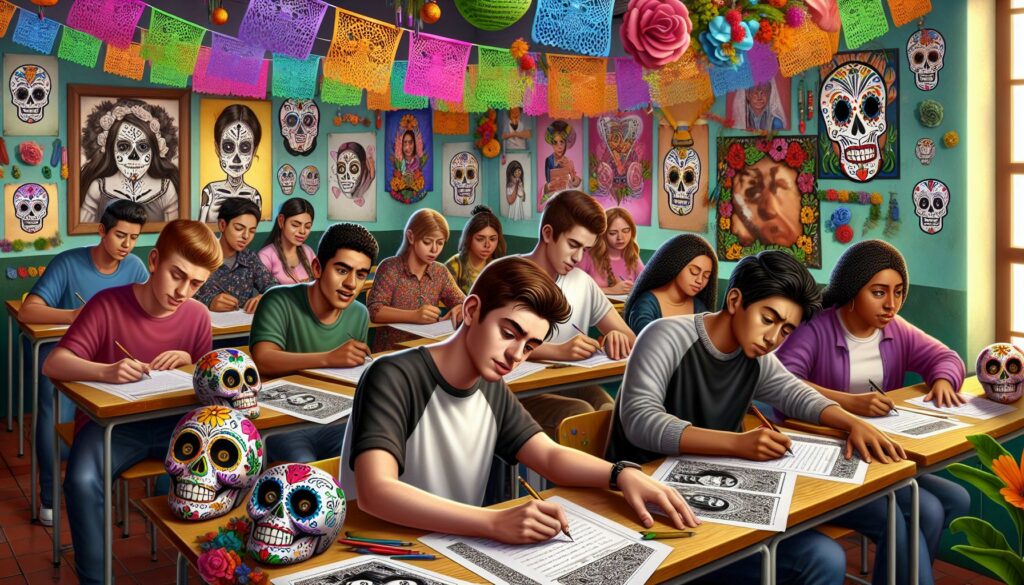Mexican literary traditions come alive each year during Día de los Muertos with the playful art of calaveritas literarias – short poems that poke fun at death while celebrating life. These witty verses transform everyday situations into humorous encounters with La Muerte, adding a dash of satire to the solemn celebration.
In schools across Mexico and Latin America, students eagerly participate in this cherished tradition by crafting their own calaveritas. They cleverly weave together rhyming stanzas about teachers, classmates and daily school life, turning ordinary moments into extraordinary tales where Death herself might show up to a math class or lurk in the cafeteria. It’s a unique blend of creative writing, cultural heritage and lighthearted humor that teaches children to approach mortality with both respect and a smile.
Escuela:f7rejx97kfa= Calaverita Literaria
Literary calaveras embody the unique Mexican perspective on death through satirical poetry that combines humor with social commentary. These verses showcase the cultural practice of transforming somber themes into celebratory expressions during Día de los Muertos.
Origins and Cultural Significance
Literary calaveras emerged in the 19th century during Mexico’s political reformation period. Mexican journalist José Guadalupe Posada popularized these satirical epitaphs through his iconic skeleton illustrations known as “”calaveras.”” The poems originally appeared in newspapers as political critiques disguised as obituaries, targeting public figures with mockery while evading censorship.
The tradition gained prominence in Mexican schools during the 1900s as teachers incorporated calaveras into language arts curriculum. These verses reflect Mexico’s distinctive approach to mortality by combining pre-Hispanic death rituals with Catholic influences. Modern literary calaveras serve as cultural bridges, connecting generations through shared experiences of turning death-related anxiety into creative expression.
Traditional Poetic Structure
Literary calaveras follow specific compositional elements that distinguish them from other poetic forms. The verses typically contain four-line stanzas with an ABAB or ABCB rhyme scheme. Each calavera includes three core components: an introduction of the subject, a description of their encounter with Death, and a humorous ending.
Common metric patterns include:
- Eight syllables in lines 1 and 3
- Six syllables in lines 2 and 4
- Emphasis on the penultimate syllable
- Internal rhymes throughout verses
The language incorporates colloquial Mexican Spanish expressions mixed with formal poetic devices like metaphors and personification of Death as a character.
Writing Literary Calaveras in Schools
Literary calaveras transform traditional classrooms into creative spaces where students explore Mexican cultural heritage through poetry. This educational practice combines language arts with cultural studies to develop students’ writing skills while maintaining cultural traditions.
Teaching Creative Expression
Teachers guide students through the structure of literary calaveras using specific learning strategies:
- Breaking down complex poetic elements into manageable steps
- Demonstrating rhyme patterns through sample verses
- Incorporating vocabulary lessons with death-related terminology
- Creating personalized calaveras about classmates or school staff
- Practicing metaphors through descriptions of La Muerte’s appearances
- Organizing peer review sessions to refine verses
Students develop critical writing skills by crafting these poems:
- Mastering syllable counting in Spanish verse
- Learning traditional rhyme schemes (ABCB pattern)
- Understanding metaphorical language
- Developing character descriptions
- Implementing humor appropriately
Cultural Education Through Poetry
Literary calaveras serve as cultural learning tools in multiple ways:
- Students explore Mexican traditions through hands-on writing experiences
- Classes examine historical figures through biographical calaveras
- Poetry workshops connect modern students with ancestral practices
- Children learn respectful approaches to discussing death
- Teachers incorporate art history through Posada’s skeleton illustrations
- Cultural vocabulary expands through exposure to traditional terms
- Integration of history lessons about Día de los Muertos
- Development of cultural awareness through creative writing
- Enhancement of Spanish language skills for heritage learners
- Recognition of cultural perspectives on mortality
- Understanding of Mexican literary traditions
Elements of a Literary Calavera
Literary calaveras combine specific structural components to create their distinctive style. These elements work together to produce poems that reflect Mexican cultural attitudes toward death while maintaining a lighthearted tone.
Humorous and Satirical Components
Literary calaveras use playful mockery to critique their subjects through clever wordplay, puns, and ironic situations. Poets incorporate Mexican slang expressions, regional idioms, and colloquial phrases to enhance the comedic effect. The verses often exaggerate the subject’s characteristics or behaviors, turning their real-life traits into amusing encounters with Death. Common satirical devices include:
- Double entendres that reference both life and death
- Mockery of social status or profession
- Exaggerated personality quirks
- Absurd scenarios involving La Catrina
- Political commentary wrapped in humor
Death as a Central Theme
Death appears as a personified character in literary calaveras, typically portrayed as La Catrina or La Huesuda. The poems describe direct interactions between Death and the subject through specific narrative elements:
- Meeting scenarios between Death and the subject
- Dialogue exchanges with witty banter
- Physical descriptions of Death’s appearance
- Actions Death takes to claim the subject
- References to skeletal imagery
- Traditional Día de los Muertos symbols
The verses transform mortality into an approachable concept by presenting Death as a familiar figure who participates in everyday activities. This portrayal helps readers connect with cultural perspectives on death through relatable situations.
Notable Examples of School Calaveras
Elementary students craft charming calaveras about their teachers’ encounters with La Muerte:
“”Mrs. García’s Math Class””
Our teacher García with numbers in hand
Met Death one day, quite unplanned
'Your calculations are done,' Death declared
But García solved equations till Death despaired
Middle school compositions demonstrate increased complexity in storytelling:
“”The Science Lab Visitor””
Professor Santos in his white coat gleamed
When Death through microscopes screened
'Your experiments must cease tonight'
But Santos proved chemicals made Death take flight
High school students incorporate sophisticated cultural references:
“”The Literature Teacher’s Last Lesson””
Maestra Ruiz with books piled high
Spotted Death's shadow passing by
'Your library card has expired,' Death said
Yet Ruiz quoted verse until Death fled
These calaveras showcase distinctive characteristics:
- Direct references to classroom activities
- Integration of subject-specific vocabulary
- Humorous twists on academic scenarios
- Creative personification of Death as a student
Teachers create reciprocal calaveras about their classes:
“”Room 23’s Adventures””
My students typing on their keys
Made Death confused with such expertise
'Time for recess,' she tried to say
But their coding made her run away
Each example maintains traditional elements while incorporating modern educational contexts creating unique pedagogical tools that blend cultural heritage with contemporary classroom experiences.
Modern Adaptations in Education
Digital platforms transform traditional calaverita literaria assignments into interactive learning experiences. Students create multimedia calaveras using video editing software, animation tools, or digital art applications to bring their poetic creations to life.
Online collaborative platforms enable cross-cultural exchanges between Mexican schools and international institutions. Students from different countries share their interpretations of calaveras, fostering global understanding of Día de los Muertos traditions.
Social media integration expands the reach of student-created calaveras through dedicated hashtags and virtual galleries. Instagram posts showcase illustrated versions while TikTok features dramatic readings set to traditional Mexican music.
Educational technology enhances the teaching of calaverita structure through:
- Interactive rhyme scheme generators
- Syllable counting applications
- Virtual writing workshops
- Digital vocabulary builders focused on death-related terms
- Automated feedback systems for poetic meter
Virtual reality experiences place students inside historical settings where they:
- Meet famous calaverita authors
- Explore traditional Día de los Muertos celebrations
- Create 3D representations of La Catrina
- Interact with virtual characters from Mexican folklore
- Practice reciting calaveras in immersive environments
Remote learning platforms incorporate calaverita writing through:
- Synchronized poetry workshops
- Digital peer review sessions
- Online publishing platforms for student collections
- Virtual poetry slam events
- Cross-border cultural exchange programs
These technological adaptations maintain the essence of traditional calaveras while engaging modern students through familiar digital formats. Teachers integrate assessment tools that track student progress in both technical writing skills and cultural understanding.
Mexican Heritage Culture
Literary calaveras stand as pillars of Mexican cultural heritage that bridge generations through creative expression. These playful poems transform the classroom into a vibrant space where students develop writing skills while embracing their cultural roots.
Modern technology has elevated this tradition beyond traditional paper and pen allowing students to explore new creative horizons through digital platforms. The enduring appeal of calaveritas literarias proves that even centuries-old traditions can adapt and thrive in today’s educational landscape.
This unique blend of humor death and poetry continues to enrich students’ understanding of Mexican culture while fostering invaluable language and creative writing skills. It’s a testament to education’s power to preserve and reinvent cultural traditions for future generations.



